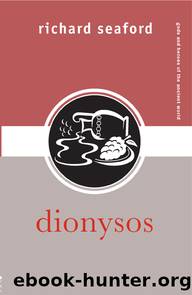Dionysos by Seaford Richard

Author:Seaford, Richard
Language: eng
Format: epub
Tags: Humanities
Publisher: Taylor & Francis (CAM)
Published: 2006-06-30T00:00:00+00:00
EARLY EVIDENCE
This is not to say that Dionysosâ association with death in myth is always directly connected with mystery-cult. The earliest surviving Dionysiac myth is in Homer: Ariadne is killed by Artemis âon the testimony of Dionysosâ (Odyssey 11.325). The story of Ariadne being united with Dionysos (and immortalised) after being abandoned by Theseus is well known (e.g. Figure 7). But there seems to have been a rare version of the myth in which Ariadne left Dionysos for Theseus: perhaps the participation of Dionysos in her death derives (as punishment) from this version. But it may in fact (also?) derive â albeit indirectly â from mystery-cult, expressing a deep structure in which Dionysos imposes death as a preliminary to immortality.
Of the four brief mentions of Dionysos in Homer, there are in fact two in which he is associated with death. The other is Odyssey 24.74: it was Dionysos who gave to Thetis the golden amphora (amphiphoreus, generally used to contain wine) that subsequently contained â in wine and oil â the bones of her son Achilles mixed with those of Patroklos.
The passage of this same golden amphora from gift of Dionysos to funerary container was described by the sixth century BC poet Stesichorus (234 PMG), and it has even been speculatively identified with the amphora carried by Dionysos as a wedding gift for Achillesâ parents on the François Vase (Chapter 2): if so, this would prefigure the frequent interpenetration of death ritual and wedding in the Dionysiac genre of Athenian tragedy. The ashes of the dead were often placed in vessels, and these vessels might often be of the kind to contain wine. This is not the only association of wine with death ritual, for it might be used also in libations or to wash the body.
In one lost play (Sisyphos) by Aeschylus the ruler of the underworld, Plouton, was called Zagreus, in another (Aigyptioi) Zagreus was the son of Hades, and in later texts Zagreus was frequently identified with Dionysos. More explicit is the statement of Aeschylusâ contemporary Herakleitos that
were it not for Dionysos that they were making the procession and singing the song to the genitals [i.e. the phallic hymn], they would be acting most shamefully. But Hades is the same as Dionysos, for whom they rave and perform the Lenaia (B15 DâK).
Download
This site does not store any files on its server. We only index and link to content provided by other sites. Please contact the content providers to delete copyright contents if any and email us, we'll remove relevant links or contents immediately.
Getting It, Then Getting Along by L. Reynolds Andiric(624)
Religion and Politics Beyond the Culture Wars : New Directions in a Divided America by Darren Dochuk(428)
Global Justice, Christology and Christian Ethics by Lisa Sowle Cahill(402)
Positive Psychology in Christian Perspective: Foundations, Concepts, and Applications by Charles Hackney(334)
Forgiveness and Christian Ethics by Unknown(323)
Douglas Hamp The First Six Days by Unknown(247)
The Horrors and Absurdities of Religion by Arthur Schopenhauer(234)
Insurgency, Counter-insurgency and Policing in Centre-West Mexico, 1926-1929 by Mark Lawrence(226)
Christian Martyrdom and Christian Violence by Matthew D. Lundberg;(216)
The Oxford Handbook of Greek and Roman Mythography by R. Scott Smith;Stephen M. Trzaskoma;(211)
Beyond Heaven and Earth by Gabriel Levy(202)
God and Eros by Patterson Colin;Sweeney Conor;(200)
The Bloomsbury Reader in Christian-Muslim Relations, 600-1500 by David Thomas;(199)
Autobiography, Volume 2: 1937-1960, Exile's Odyssey by Mircea Eliade(188)
Cult Trip by Anke Richter(186)
Witches: the history of a persecution by Nigel Cawthorne(183)
An Introduction to Kierkegaard by Peter Vardy(172)
The Global Repositioning of Japanese Religions by Ugo Dessi(167)
The Myth of Disenchantment by Jason A. Josephson-Storm(166)
